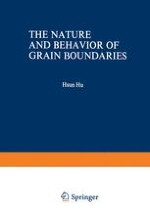1972 | OriginalPaper | Chapter
Behavior of Grain Boundaries Near the Melting Point
Authors : C. L. Vold, M. E. Glicksman
Published in: The Nature and Behavior of Grain Boundaries
Publisher: Springer US
Included in: Professional Book Archive
Activate our intelligent search to find suitable subject content or patents.
Select sections of text to find matching patents with Artificial Intelligence. powered by
Select sections of text to find additional relevant content using AI-assisted search. powered by
The absolute grain boundary energies of {011} tilt boundaries in bismuth at a temperature very near the melting point were measured over the range of misorientations 0.5° to 14.5°. A study of the structure of these boundaries was extended as far as 27°. The results at small tilt angles (θ≤6°) can be described accurately in terms of a heterophase dislocation model. This model also correctly predicts the grain boundary energies of [001] tilt boundaries in copper near the melting point, again for tilt angles less than about 6°. The heterophase dislocation model is unique, inasmuch as it permits the calculation of absolute grain boundary energies in terms of usually available thermodynamic and elastic quantities and a simple macroscopic parameter related to the boundary structure. In addition, the theory provides a basis for interpreting the structural transition observed in bismuth tilt boundaries at intermediate misorientations (θ=15°). Finally, the failure of current theories to predict the correct energy-misorientation dependence over a wide range of misorientations is ascribed to linear and nonlinear interactions among the misfit dislocations—interactions which increase rapidly in importance for misorientations above about 5°. For a quantitative description of the energetic behavior of higher angle grain boundaries than are treated at present, a theory which accounts for such interactions appears to be required.
